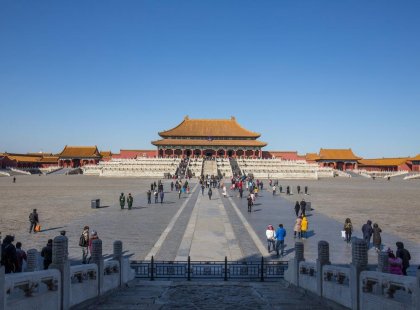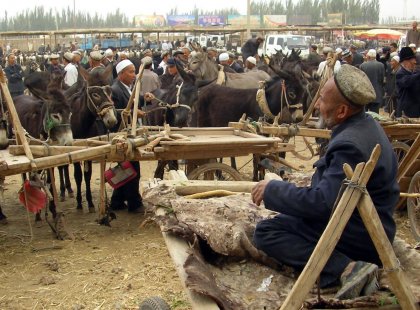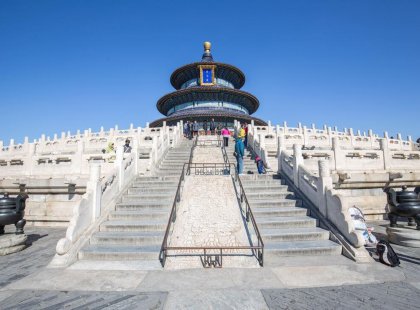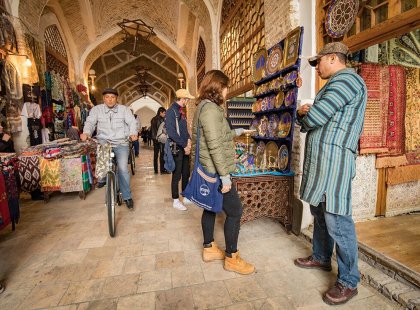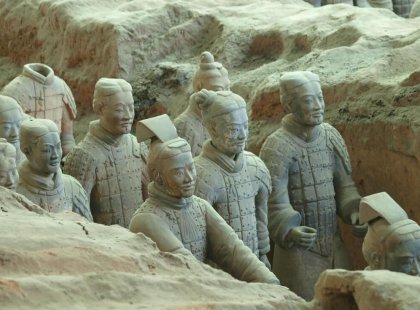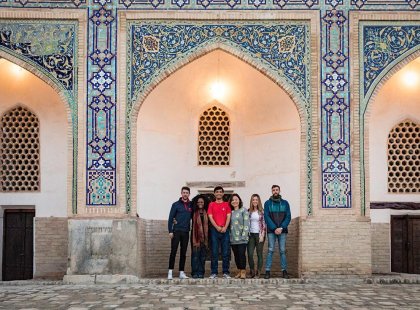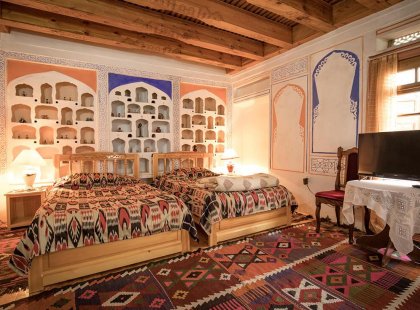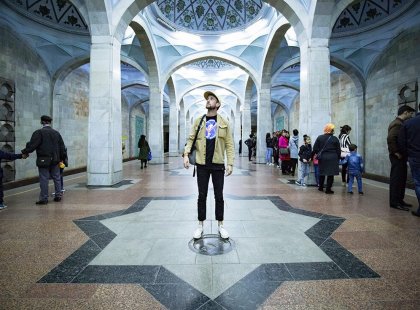The Great Silk Road
32 days
from Beijing to Tashkent
From
$ 6525
Duration32 days
Travel the Silk Road from China to Uzbekistan. Unlock the secrets of the Silk Road on this immersive journey across Central Asia. From Beijing all the way to Tashkent, this epic 32-day trip heads west across China, showcasing stunning relics, dynastic palaces, Muslim minarets, hidden grottoes and rock-cut Buddhist masterpieces. Continuing into Kyrgyzstan and on to the heartland of Uzbekistan, be dazzled by Central Asia proper: the tranquil landscape of Song-Kol Lake; Solomon's Throne in historic Osh; and the superb mosques of Samarkand. Full of warmly hospitable locals, spectacular expanses and constant evocations of a legendary past, this is the Silk Road at its magical best.
-
Duration: 32 daysService level: Standard
-
Starts in: BeijingPhysical Grading: Average
-
Ends in: TashkentAges: 15+
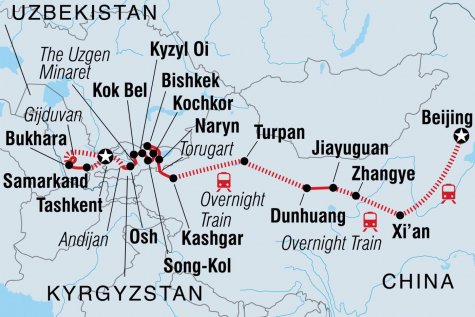
Itinerary
Day 1: Beijing
Start place: Beijing
Nimen Hao! Welcome to Beijing - the capital of the most populous country on earth. China's capital is quickly shedding its historical face in favour of modernity, however there are still plenty of places that give an insight into the nation's ancient past, as well as sights that showcase China's contemporary culture. Your adventure begins with a welcome meeting at 6pm today, where your insurance and next of kin details will be collected. Please look for a note in the hotel lobby or ask the hotel reception where the meeting will take place – if you're going to be late, please inform the hotel reception. Any free time today in Beijing is taken at your leisure, so get out and start exploring this vast and amazing city. It's recommended that you arrive a few days early to experience all that Beijing has to offer. Beijing's food is a highlight, from the famous Beijing Roast Duck to dumplings in a tiny backstreet eatery, there’s no chance you’ll go hungry here!
Day 2: Xi'an
Catch the bullet train to Xi'an (approximately 5-6 hours). Once the imperial centre of China for 2,000 years, Xian is now a vibrant, modern city dotted with many interesting historical sites to explore. Enjoy a walking tour of the Muslim Quarter of Xi'an with your group. After the walking tour, why not visit the Great Mosque, one of the most important in China. This area has plenty of interesting shops, lively street stalls and roving groups of white-bearded men in skull caps. This evening enjoy some free time to uncover what was once the start of the ancient trading route of the Silk Road.
Day 3: Xi'an
Enjoy a free day to explore Xi'an at your leisure. Perhaps hire a bike and ride along the city walls, which are the most complete in China, or climb to the top of the Bell and Drum towers for impressive views. Perhaps visit the impressive Tang Dynasty Small or Big Wild Goose Pagodas. The Big Wild Goose Pagoda is in a scenic area which also includes the Shaanxi History Museum and Da Cien Temple. It's very popular with locals, especially in the evenings when there is a nightly light and music show around the many fountains. The Small Wild Goose Pagoda is inside the Jianfu Temple and Xi'an Museum is also nearby.
Day 4: Xi'an - Overnight Train
Today you’ll journey out in to the countryside surrounding Xi’an (approximately 2 hours) and visit what is undoubtedly one of the man-made wonders of the world – the Terracotta Warriors. You’ll learn all about this incredible archaeological find, discovered after being buried for 2,000 years by farmers digging a well in 1976. These clay statues of soldiers, horses and chariots (and originally individually painted) were commissioned by the emperor Qin Shi Huangdi as part of his mausoleum after he ascended to the throne in 264 BC. Three main pits are open for you to view, where over 1,000 warriors are displayed – each individually sculpted from clay, each having a different costume, height, and even facial expressions – stand in battle formation. The scale is incredibly impressive.In the evening the group boards the first overnight train to Zhangye.
Train travel in China may not be entirely luxurious but it's certainly one of the best ways to come face to face with the country and its people as it's the main form of transport for locals. We use hard sleeper class trains for most of our overnight train journeys. These are not as rough as they sound – compartments are open-plan, clean, with padded three-tiered berths (6 to a compartment). Sheets, pillows and a blanket are provided. Some travellers prefer to bring their own sleeping sheet. Safe, hot drinking water is always available. It is a good idea to bring a mug, spoon, knife and fork if you will be preparing your own hot drinks or food on the train (as these are not provided in cabins). Basic bathroom facilities with toilets and washbasins are situated at the end of each carriage. As toilet paper isn't always available, it's best to bring an emergency supply. Keep in mind general train cleanliness may not be to the same standards you are accustomed to. Food is available on the train, but it's a good idea to stock up on snacks for the trip.
Train travel in China may not be entirely luxurious but it's certainly one of the best ways to come face to face with the country and its people as it's the main form of transport for locals. We use hard sleeper class trains for most of our overnight train journeys. These are not as rough as they sound – compartments are open-plan, clean, with padded three-tiered berths (6 to a compartment). Sheets, pillows and a blanket are provided. Some travellers prefer to bring their own sleeping sheet. Safe, hot drinking water is always available. It is a good idea to bring a mug, spoon, knife and fork if you will be preparing your own hot drinks or food on the train (as these are not provided in cabins). Basic bathroom facilities with toilets and washbasins are situated at the end of each carriage. As toilet paper isn't always available, it's best to bring an emergency supply. Keep in mind general train cleanliness may not be to the same standards you are accustomed to. Food is available on the train, but it's a good idea to stock up on snacks for the trip.
Day 5: Zhangye
Disembark after an overnight train ride to Zhangye, arriving at around midday. Check into your hotel and take an orientation walk with the group leader around this leafy town of temples and parks. The city was established 1000 years ago as the headquarters of General Huo when he controlled the ‘Hexi Corridor’. Controlling this area meant controlling the lucrative Silk Road, as the corridor is one of the few ways through the Qilian Mountains to the north and the desert and peaks to the south. Zhangye is home to China’s largest reclining Buddha, which would have been visited by Marco Polo in the 13th century while he waited for permission from Kubilau Khan to continue on to the Mongolian capital. Relax with free time for the rest of the afternoon and evening as you prepare yourself for some truly spectacular scenery tomorrow.
Day 6: Zhangye - Danxia Geological Park
Today pack your sunscreen, hat and water as you head to see the unreal landscapes of Zhangye Danxia Landform Geological Park, where it looks like millions of coloured paint pots have been spilled across the mountains. This 400-square-kilometer World Heritage site was formed over 24 million - 100 million years ago. The area was originally a lake fed by rivers, which brought many layers of sand and mineral deposits. When the lake dried up the mineral elements oxidised, giving the lake its unique colour palette. The elements then eroded the lake into mountainous shapes and unusual formations. The result looks like an oil painting, with colours ranging from pink and orange to earthy brown. The scale of the formation and the swirling patterns of rainbow colours are stunning. Take a hike around this grand and magnificent area at sunset, and discover that every angle is a photographers dream.
Day 7: Jiayuguan
Today there is an option to rise early and return to the Zhangye Danxia Landform Geological Park for an unforgettable sunrise over the hills. Later at midday the group will catch a day train to Jiayuguan (approximately 1.5-2 hours). Jiayuguan was the last outpost on the edge of the ancient Han Chinese Empire, the last Chinese-controlled stop for travellers and traders before they passed into the uncertain and dangerous deserts beyond. While exploring the city you might notice the growing Muslim influence as we travel further west.
Day 8: Jiayuguan - Dunhuang
Today explore Jiayuguan Fort and a remote section of the Great Wall, which you will either visit today before heading to Dunhuang. The Ming dynasty built a series of forts and towers in Jiayuguan to secure their hold over the area and Jiayuguan Fort, though restored, still offers a feeling of desolation as you look out into the desert from atop its walls. Here we visit a section of the Jiayuguan Pass, which is the western end of the Great Wall built during the Ming Dynasty. Travel to Dunhuang in the afternoon, which is about five hours drive.
Day 9: Dunhuang
This morning the group can decide if they want to drive out of the city and watch the sun rise over the nearby dunes at Crescent Lake. The oasis, which take the shape of a crescent moon, is believed to have existed for around 2,000 years and is surrounded by Mingsha Shan (Singing Sand Dunes). Today you will also visit the nearby Mogao Caves, which house some of the most stunning Buddhist murals in the world, and are perhaps the greatest store of Buddhist art in the world. The first cave was carved out and painted in 366 AD after a Buddhist monk, passing through on the Silk Road, had a vision of a thousand Buddha faces appearing on the cliff. The caves were largely forgotten until a Taoist monk stumbled upon them in 1907. Currently there are more than 492 caves, most containing murals, manuscripts, and over 2,415 coloured statues. Return to your hotel in Dunhuang for the night and perhaps enjoy a drink at the unique beer gardens off the nearby night market.
Day 10: Turpan
Travel by private bus this morning to Liuyuan train station and board a day train to Turpan (approximately 3.5 hours). A transfer will be waiting in Turpan to take you to the hotel. Once an important staging post on the Silk Road, Turpan is an attractive oasis town famous for its vineyards, stone fruits, melons and the nearby Flaming Mountains. The Turpan Depression is second only to the Dead Sea in Jordan as the lowest point on earth. It's a small city by Chinese standards, but the surrounding area is full of interesting places. The country roads on the outskirts are lined with poplars and the lovely old mud brick dwellings of the Uyghur people, while the modern ‘inner’ town has shiny new buildings, spacious streets and public squares.
Day 11: Turpan
Explore Turpan with your local guide. Visit the ruins of the once great Silk Road city of Jiaohe, one of Xinjiang’s best historical sites and one of the most rewarding to visit. Bring plenty of water and sunscreen with you as things will be heating up! During free time this afternoon, choose to join the locals socialising in the square, or visit the market tonight for all the flavours of the region and plenty of interaction.
Day 12: Overnight Train
Take the last train journey to Kashgar, which departs between 11am and 1pm (approximately 24 hours). See mirages in the Turpan basin, then climb through a high mountain pass, switch-backing up the peak of the Tian Shan Mountains. By morning you will have descended down the other side into the Tarim basin, skirting the northern edge of the sandy Taklamakan desert, passing isolated communities eking out a living in a harsh environment.
Day 13: Kashgar
Arrive into Kashgar around midday today. Once a frontier town straddling the crossroads of empires and trading routes, Kashgar is now very much a modern, fast developing city that continues to take advantage of its geographical position near the border of Pakistan and Central Asia. Far from Beijing it may be, but there are still plenty of signs that you are still in China, such as the country's largest Chairman Mao statue.
The once extensive Old Town is just about all but gone, with only a few areas still left to be demolished or rebuilt under the guise of it being overcrowded, with poor drainage and vulnerable to earthquakes. There has been a huge loss of culture with Uyghur families being relocated to newly built apartments.
The town's main landmark is the Id Kah Mosque and its surrounding square. The dusty old laneways are crammed full of shops, food stalls and Uyghur locals living a lifestyle virtually unchanged for a hundred years. Take advantage of the proximity to Pakistan by having a meal of curry and chapattis at a Pakistani café or play a round or two with the lads hanging out at the pool tables on Id Kah Square. Alternatively, you can get lost meandering down lanes and alleyways, stopping at stalls selling tandoori-baked bagels or mulberry juice.
The once extensive Old Town is just about all but gone, with only a few areas still left to be demolished or rebuilt under the guise of it being overcrowded, with poor drainage and vulnerable to earthquakes. There has been a huge loss of culture with Uyghur families being relocated to newly built apartments.
The town's main landmark is the Id Kah Mosque and its surrounding square. The dusty old laneways are crammed full of shops, food stalls and Uyghur locals living a lifestyle virtually unchanged for a hundred years. Take advantage of the proximity to Pakistan by having a meal of curry and chapattis at a Pakistani café or play a round or two with the lads hanging out at the pool tables on Id Kah Square. Alternatively, you can get lost meandering down lanes and alleyways, stopping at stalls selling tandoori-baked bagels or mulberry juice.
Day 14: Kashgar
Kashgar's main attraction is undoubtedly the Sunday Bazaar, which you’ll visit today. It’s said to be the biggest market in Asia, and on its main day it can feel like everyone from hundreds of miles around has converged on the city. It’s alive with traders selling all kinds of wares – rugs, hats, spices, boots, dates, ingredients for traditional medicines, auto parts, you name it. The Bazaar is divided into two sections – the Downtown Bazaar, which sells clothing, household goods, produce and everything else you could imagine, and the Animal Bazaar just outside the city. Taking a private van, first travel out to the Animal Bazaar to see the frantic bargaining and bustle of local herdsmen and farmers (watch as they even take donkeys for a 'test drive'). It’s certainly a memorable scene to see every farmer, handler, sheep, cow, camel, horse and donkey from the surrounding villages packed into a small square overflowing with sound and smell. Then return to the city to visit the main bazaar and mingle with the traders and shoppers at your own pace. Perhaps join the locals in Id Kah Square on this free evening.
Day 15: China/Kyrgyzstan border - Torugart Pass - Naryn
Say goodbye to your Chinese leader and group today, and travel onwards with other group members who are completing the Beijing to Tashkent journey.
Depart early morning by private bus for our journey into the seldom-travelled country of Kyrgyzstan, a nation that still embraces nomadic traditions and extends some of the warmest hospitality you'll find anywhere in the world. We'll be travelling for around 11 hours today, including approx 7 hours of driving, plus border formalities (which can require a lot of patience and plenty of waiting).
You will be accompanied by a Chinese Intrepid representative to the border and then meet your new driver and escort on the Kyrgyzstan side who will be with you until we meet the Central Asia group at Bishkek tomorrow.
We cross the breathtaking Torugart Pass (3570m) high in the Tian Shan, slated as the most exciting route into Central Asia - take note of the changing landscape between China and Kyrgyzstan - and drive down to Tash Rabat (3500m), a beautifully preserved caravanserai of the 14th century. There is very little public transport in Kyrgyzstan so to make the most of our time here we have a private van for our journeys. It can be a rough ride in places today and often gets quite cold as we ascend higher into the mountains even in mid summer, so make sure you bring some warm clothes!
Drive on to Naryn where we stay in a hotel tonight.
Depart early morning by private bus for our journey into the seldom-travelled country of Kyrgyzstan, a nation that still embraces nomadic traditions and extends some of the warmest hospitality you'll find anywhere in the world. We'll be travelling for around 11 hours today, including approx 7 hours of driving, plus border formalities (which can require a lot of patience and plenty of waiting).
You will be accompanied by a Chinese Intrepid representative to the border and then meet your new driver and escort on the Kyrgyzstan side who will be with you until we meet the Central Asia group at Bishkek tomorrow.
We cross the breathtaking Torugart Pass (3570m) high in the Tian Shan, slated as the most exciting route into Central Asia - take note of the changing landscape between China and Kyrgyzstan - and drive down to Tash Rabat (3500m), a beautifully preserved caravanserai of the 14th century. There is very little public transport in Kyrgyzstan so to make the most of our time here we have a private van for our journeys. It can be a rough ride in places today and often gets quite cold as we ascend higher into the mountains even in mid summer, so make sure you bring some warm clothes!
Drive on to Naryn where we stay in a hotel tonight.
Meals: L, D
Day 16: Bishkek
Travel on to Bishkek, where you will have free time until you meet your new group and leader at 6pm tonight.
Meals: B, D
Day 17: Bishkek
Take a trip down memory lane today with a city tour showcasing the country's fascinating history. The centre of the city is Ala-too Square, which was known as Lenin Square in Soviet times. Lenin used to stand in his concrete overcoat in the middle of this square, proudly gesturing towards the mountains. A great place for a wander is Dubovy (Oak) Park, where you'll find a few open-air cafes. The century-old oaks here and all along Freedom Avenue make Bishkek one of the greenest cities in Central Asia. In the afternoon, you'll have some free time to further explore Bishkek. Quite the contrast to the relaxed quiet streets, square and parks in the city center, Osh Market is noisy, crowded, and a perfect peek into local life. You'll find all kinds of things on sale here from spices and fruits to clothes and carpets. Get together with your travel mates and enjoy an optional final dinner together tonight to celebrate a great journey through Kazakhstan and Kyrgyzstan.
Meals: B
Day 18: Don Aryk - Issyk Kul - Kochkor
Drive 60 km to the 11th-century Burana tower, an ancient minaret from the Silk Road period. In the nearby village of Don Aryk, visit a local home. Reflecting the important role horses have played in the traditional Kyrgyz nomadic life style, the country is famous for at least four types of horse games such as odarysh or wrestling, tiyin-enish, where riders try to pick up coins at full gallop and kok buru or buzkashi, a type of goat-snatching polo. We'll take the chance here to watch the how the locals play some of these horse sports here and enjoy a tasty lunch with the family. Continue to Issyk Kul lake – the second largest alpine lake in the world. This beauty is one of the biggest natural water reservoirs in the world, at 170 km long and 70 km wide. A combination of extreme depth, thermal activity and mild salinity means the lake never freezes. Next, continue to Kochkor. Explore a small local market in the centre of the village, and, depending on our arrival time, a local co-op that provides training for local women in traditional handicrafts.
Meals: B, L, D
Day 19: Son-Köl
Make the 130 km drive to Son-Köl, one of the largest lakes in the country. This beautiful alpine lake is considered a sacred place for many Kyrgyz people as well as one of the best summer pastures for nomadic herders. In the middle of the summer, you'll see nomadic herdsmen and their families watching over goats, sheep, and horses. Enjoy exploring your surroundings for the rest of the day. There are many beautiful lake trails to hike along. Alternatively you may be able to visit some ancient petroglyphs in the local area, or visit a nomad camp for a first-hand look at nomadic life. Simply sit and take in this beautiful corner of the world. Tonight we stay in yurts set up along the lake shore. Made of felt and tarpaulins on a round frame, yurts are the traditional dwellings of the Kyrgyz people. Sleeping arrangements are on a multi-share, mixed-gender basis with mattresses on the floor. It can get very chilly in the evenings, so there's a stove for heating and plenty of blankets. There are no bathroom facilities inside the yurts, so outdoor toilets are to be expected. Those daring enough for an invigorating morning splash can use the lake nearby. All meals are included during our stay here.
Meals: B, L, D
Day 20: Kyzyl-Oi
Today you travel along gravel roads to the tiny village of Kyzyl-Oi squeezed between the mountains. On our way, we will pass large coal deposits and travel along the Kökömeren river which feeds into the Syr Darya - one the major rivers of Central Asia that used to fill the Aral Sea. Enjoy a picnic lunch on the banks of the river in the shade of the trees and use your free time to explore the village once we arrive.
Meals: B, L, D
Day 21: Suusamyr Valley - Chychkan - Kok-Bel
A full day of driving though big, beautiful landscapes today. As the roads in Kyrgyzstan see little regular maintenance, even short distances on a map can take hours. The road crosses the Suusamyr Valley – a high steppe plateau situated at around 2,200 metres above sea level. The mountainous, lush surroundings are often photogenically dotted with yurts. We then follow the Chychkan river that cuts through the Tien Shan range. Stop here for a while and soak up the amazing scenery. You will arrive at tonight's accommodation in Kok-Bel sometime in the early evening.
Meals: B, L, D
Day 22: Osh
After breakfast, get ready for another all-day journey to the second-largest city in Kyrgystan – Osh. Located in the Fergana Valley in the south of the country, Osh is often referred to as the 'Capital of the South'. With a history that dates to the 500 BC. Stop en route at Uzgen, an ancient trading town and handicrafts center on the Silk Road. Although much of the ancient city has been destroyed, a minaret and three mosques that have survived to this day remain important examples of medieval Central Asian architecture.
Meals: B, L
Day 23: Osh
Rise and shine for a visit to the only World Heritage Site in Kyrgystan – Sulaiman-Too Sacred Mountain, also known as Solomon's Throne. For centuries Silk Road travellers have sought out the mountain's caves and their petroglyphs in the belief that they would be blessed with longevity. Visit the National Historical & Archaeological Museum Complex. In the afternoon, enjoy some free time. Perhaps visit the Jayma Bazaar, where you might pick up an interesting souvenir or two. Or maybe take a self-guided tour of the remnants of Osh's soviet past with a walk to the giant Lenin statue in the city square. The many murals praising the Soviet Union also give an idea of just how deeply these ties went.
Meals: B, D
Day 24: KGZ/UZB border crossing - Andijan - Tashkent
This morning we drive to Kyrgyz – Uzbek border which is just outside of the city. After passing through the border (approx. 1-2 hours), we meet farewell our Kyrgyz guide, meet our new Uzbek guide and transfer to Andijan. From here we take a local train to Tashkent (approx. 5.5 hrs). Arrive at our Tashkent hotel in the evening.
Meals: B
Day 25: Tashkent
Begin your introduction to Uzbekistan by exploring the capital today. Our sightseeing today in Tashkent will include a visit to State History Museum, the Abdul Khasim Medrassah with its hujra cells used as metalwork craft workshops to produce jewellery and other goods, and the Khast Imom Complex. After lunch, lose yourself in the exciting Chorsu Bazaar, browsing traditional wooden cradles, handmade musical instruments, and the extensive vegetable and spice markets.
Meals: B
Day 26: Samarkand
Transfer to the station for the high speed train to fabled Samarkand (approx 2 hours). This city is located at the very centre of the ancient Silk Road. Enjoy some free time in the city on arrival, saving some of the key sights for our tour tomorrow. Maybe inspect the remains of the remarkable medieval observatory developed by Ulug Beg, Tamerlane's (Amir Timur) brilliant astronomer grandson. These days, only half of the below-ground semi-circular track can be seen, but there is an the excellent small museum close by. Or visit the Afrosiab Museum with its fine collection of treasures unearthed from the site, including world famous 10th century frescoes.
Meals: B
Day 27: Samarkand
Be blown away by the sights you'll take in today. First, the great central square of Samarkand, the Registan. Then, Guri-Amir, where Tamerlane is buried, and finally the enormous Bibi-Khanum Mosque. Then we drive to Konigil village in the outskirts of the city for a special lunch with a family who have been making paper by traditional methods as long as they can remember. After lunch we'll learn about this unique way of paper making from mulberry. Returning to Samarkand, visit the impressive Shak-i-Zinda ensemble of mausoleums. This unusual necropolis has monuments from the 14th and 15th centuries, reflecting the development of the monumental art and architecture of the Timurid dynasty and is photo worthy at every turn.
Meals: B, L
Day 28: Samarkand - Shahrisabz - Bukhara
Continue tracing the Silk Road towards Bukhara. One of the most important portions of this ancient route connects these two major cities of the area and takes us through the town of Shahrisabz - the home town of revered national hero Tamerlane. Sadly, Shakhrisabz has recently lost much of its authentic flavour through over enthusiastic restoration works. We make a stop here, visiting the legendery Ak Saray Palace, Dor-ut Tilovat Memorial Complex, Dorus Saodat Complex and Kok-Gumbaz Mosque. Then we'll continue to Bukhara where we we stay for the night.
Meals: B
Day 29: Bukhara
Today, we'll enjoy a full day of sightseeing in beautiful Bukhara. First, you'll visit the lovely Sitora-i Mohi Khosa, once the summer residence of the last Emir. Designed by Russian architects, it has lavish interiors decorated
with traditional filigree plaster, mirrored surfaces and delicate floral wall paintings by local artisans. Then to the peaceful 16th century Chor Bakr necropolis, where you'll enjoy the simplicity of the Khonako-Medressa & Mosque complex that is typical of Bukharian style. In the afternoon, visit the Ark Fortress and Kalon Mosque, the symb of Bukhara, then to one of Central Asia's oldest and most exquisite structures, the 10th century Ismail Samani Mausoleum, whose superb decorative brickwork has survived 1,000 years of rugged history. From here it is only a short distance to the Lyabi-Haus area. After dinner, there's time to wander the small craft studios tucked into the ancient nearby madrassas and trading domes.
with traditional filigree plaster, mirrored surfaces and delicate floral wall paintings by local artisans. Then to the peaceful 16th century Chor Bakr necropolis, where you'll enjoy the simplicity of the Khonako-Medressa & Mosque complex that is typical of Bukharian style. In the afternoon, visit the Ark Fortress and Kalon Mosque, the symb of Bukhara, then to one of Central Asia's oldest and most exquisite structures, the 10th century Ismail Samani Mausoleum, whose superb decorative brickwork has survived 1,000 years of rugged history. From here it is only a short distance to the Lyabi-Haus area. After dinner, there's time to wander the small craft studios tucked into the ancient nearby madrassas and trading domes.
Meals: B
Day 30: Gijduvan - Bukhara
Historically, Gijduvan was one of the caravan stops on the way to Bukhara. Ulugbek, the famous astronomer ruler of Samarkand and grandson of Tamerlane, built a medrassah here, just next to the grave of a Sufi saint. The town gained further fame as a centre of glazed pottery production. Visit the private studio of a local ceramic artist, meet the family and watch them at work. Later you can have some free time to explore this small town. For lunch we recommend the juicy kebabs of Gijduvan that are famous throughout Uzbekistan. On your way back, stop to see a minaret from the late 12th century in Vobkent.
Meals: B
Day 31: Tashkent
Enjoy some free time for your own optional sightseeing in Bukhara. In the afternoon, take a fast train back to Tashkent followed by an optional farewell dinner with your fellow travellers.
Meals: B
Day 32: Tashkent
There are no activities planned for the final day and you are able to depart the accommodation at any time.
End place: Tashkent
Meals: B
Inclusions
Included
- Xi'an - Muslim Quarter walking tour
- Xi'an - Terracotta Warriors
- Zhangye - Danxia Landform Geological Park
- Jiayuguan - Hanging Great Wall
- Jiayuguan - Fort
- Dunhuang - Mogao Caves
- Dunhuang - Crescent Moon Lake & Singing Sand Mountains
- Turpan - Jiaohe Ancient City
- Bishkek - City Tour
- Shamsy Valley - Burana tower
- Don Aryk - Local home visit & horsemanship demonstration
- Kochkor - Market
- Kochkor - Women's Felt Co-op
- Uzgen - Uzgen Minaret & Complex
- Osh - Sulaiman-Too Mountain
- Osh - National Historical and Archaeological Museum Complex
- Tashkent - Chorsu Bazaar
- Tashkent - Khast Imom Complex & Moyie Mubarek Library Museum
- Tashkent - History Museum of the People of Uzbekistan
- Samarkand - Bibi-Khanym Mosque
- Samarkand - Gur-e-Amir Mausoleum
- Samarkand - Shakh-I-Zinda
- Samarkand - Registan
- Samarkand - Paper making workshop & home cooked lunch
- Shakhrisabz - Ak Saray Palace
- Shakhrisabz - Kok-Gumbaz Mosque
- Shakhrisabz - Dor-ut Tilovat Memorial Complex
- Shakhrisabz - Dorus Saodat Complex
- Bukhara - Ismail Samani Mausoleum
- Bukhara - Sitorai Mohi Hosa Palace
- Bukhara - Chor-Bakr Necropolis
- Bukhara - Ark Fortress
- Bukhara - Kalon Mosque
- Vobkent - Minaret
- Gijduvan - Ceramics workshop
-
Transport
Overnight Sleeper Train, Private Bus, Public Bus, High Speed Train, Metro/Subway -
Accommodation
Hotel (23 nts), Overnight Sleeper Train (2 nts), Guesthouse/Homestay (5 nts), Yurt (1 nt)


